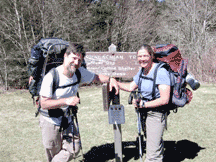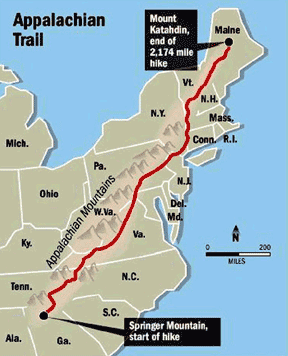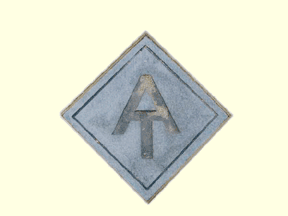|
||||||
The Tale of a Trail
|
 |
The Reshetiloffs packed 20 boxes of supplies to be sent by family to mail drops along their route from between Hiawassee, Georgia, to Monson, Maine. |
So why would anyone choose to spend six months hiking over mountains, through snowdrifts and thunderstorms while suffering the inevitable blisters, bug-bites and all around general discomfort?
For some, it’s a rite of passage.
Some search for spiritual enlightenment or answers to life’s questions.
Others hike to get through a challenging life experience: a divorce, an empty nest or the loss of a loved one.
Still others try to lose the person they’ve become in search of the person they hope to be.
Greg and Kathy weren’t looking for or running from anything. For them, it was simply a way to take a “great vacation.”
They hoped to hike the entire length of the trail, but both agree reaching Mt. Katahdin wasn’t their initial goal. At least in the beginning, they said they wouldn’t be “upset” if they didn’t get that far.
As they both philosophized, “It’s not the goal, it’s the journey. The goal is the journey.”
Planning for the Trail
The Reshetiloffs’ journey began with a wall map of the entire trail and grease boards became part of their home décor.
“I’m normally not a list-maker,” Kathy says. “But I became a compulsive list-maker while planning this hike.”
Their to-do lists included banking, bill paying, packing and forsaking.
“When you start to iron out the little things, it starts to overwhelm you,” Greg said. “How much toilet paper should we pack in each mail drop? Am I going to shave? How many razor blades will I need?”
And what about their house?
They had thought about renting it for the six months or of asking a friend or relative to housesit.
In the end, they turned off the utilities and locked the doors.
Early on, they agreed to do everything possible to minimize the hardships and “have a great time on the trail.” Neither was going to suffer through meals of “Ramen and peanut butter.”
Figuring they would each need to consume around 4,000 calories a day to maintain their strength, Greg and Kathy prepared and dehydrated over 75 meals.
“Just about all the meals we prepared came out excellent,” says Kathy. “But the best was the seafood chowder we ate in North Carolina, on top of Standing Indian Mountain. We made it using dried tomato sauce, clams, shrimp, tuna and a bunch of veggies. Yum.”
They could carry only four to five days’ worth of food in their backpacks. Using maps and trail guides, they calculated the distances between towns along the way and mapped out where they would leave the trail for restocking.
Boxes were packed with items including seasonal clothing changes, toiletries and four to six days’ worth of food. Each box was pre-addressed (marked hold for hiker) for general delivery to post offices in towns along the trail. Family members agreed to ship these mail drops on predetermined dates. The Reshetiloffs planned for 20 mail drops between Hiawassee, Georgia, and Monson, Maine.
On the trail, the hikers would “hike into town, find the post office and pick up the box.”
Not ones to pass up a cocktail at the end of a hard day’s work, the intrepid hikers devised a way to pack enough vodka to enjoy a nightly happy hour around their campfire.
“Most hikers carry at least two liters of water,” Greg says. “But it was a wet year and water was easy to find on the trail. So we each carried one liter of water and a half-liter of vodka for cocktails. Additionally, one liter was packed with each of our 20 mail drops. Having that one drink at the end of the day was probably our biggest luxury. There were only three days on the trail that didn’t conclude with a toast to the day’s achievement, and two of those three were skipped due to complete exhaustion.”
In addition to food and drink, between them they carried sleeping bags, sleeping pads, a tent, clothing, a water filter, a white gas camp stove, a cook set, utensils and basic toiletries. In a nod to technology, they began a web journal of their hike so family and friends could keep track of their progress. For this, they brought along a small, handheld computer and portable keyboard. One of their town tasks was to locate an internet connection and update their journal.
With their daily existence whittled down to the basic necessities for survival — and a little bit of comfort — the packs were put on a scale. Kathy’s weighed in at 37 pounds, and Greg’s came in at 44 pounds. Including vodka.
Initiation
March 21, 2006, found Greg and Kathy on Springer Mountain at the south terminus of the Appalachian Trail, right on schedule.
As they began the long hike north, they were not only entering the wilderness, they were steps away from
 |
Trail angels often appear bearing food and other supplies just when the hikers thought they could not take another step. |
becoming a part of a unique trail community.
Appalachian Trail hikers are part of a club whose members aren’t defined by income, gender, occupation or heritage, but by a shared experience and goal.
Trail nomenclature and rituals soon become part of a hiker’s life.
Thru-hikers or 2,000 milers are endeavoring the entire 2,175 miles at one time. Section hikers hike the trail in chunks, sometimes over the course of many years.
The generous people who appear bearing gifts of fresh fruit, cold beer or simply encouraging words are called trail angels. Hikers tell stories of trail angels suddenly appearing just when they didn’t think they could take another step. This trail magic gave them the strength to go on.
Trail names are identities assumed for the duration of the hike. Some hikers pick their own names; others are named by fellow hikers.
Before starting out, neither Reshetiloff had much interest in joining the club. They hadn’t given any thought to trail names.
But just seven days into the hike, they were inducted.
“We got trail names today,” Kathy wrote in her journal. “Someone heard Greg call me Cake and on the trail asked him Where’s Cake?”
That became my trail name. Then he said I guess I should be Pie. We changed them a little. He is Pi and I am K’ache (because I was always aching).”
Walking the Trail
Days turned into weeks, weeks into months. Pi and K’ache, having left their suburban existence back in Edgewater, now embraced the daily routine of life on the Appalachian Trail.
When they started hiking, it was still winter. Trees were bare and wildflowers yet to bloom.
“One of the most awesome things was walking through the seasons,” Greg says. “From winter into spring, then summer into fall, we became a part of the season.”
Daily entries in their trail journal almost always included a list a wildlife they encountered and plants they were able to identify, including trillium, bloodroot, Jack in the Pulpit, Solomon’s seal and wild geranium.
The sound of birds was ever-present, especially once spring arrived. Try as they may, they couldn’t identify all of the voices, so they used their hand-held computer to record the birdsongs. “My cousin is associated with Audubon,” Kathy said, “so we decide to record the birds, hoping he would be able to identify it later.”
Leaving the trail and hiking into towns are necessary parts of a long-distance hike, not only to re-stock supplies but for a much-needed break to revive the trail-weary body. A trip into town promised a hot shower, a visit to a laundromat, all-you-can-eat buffets, ice cream, cold beer and a night’s sleep on a soft mattress between clean sheets.
In spite of the creature comforts of town, the Reshetiloffs were always eager to get back into the woods and the routine of the trail.
A typical day began around 7am. “We wake up early,” Kathy wrote in their trail journal, “break up camp, make breakfast, dress and hit the trail.”
They hiked an average of 14 miles a day. At day’s end, they set up camp, enjoyed their ritual cocktail and cooked dinner over their camp stove. Sometimes they slept in their tent, sometimes in the trail shelters and sometimes under the stars.
In the morning, they’d wake up and do it all over again.
“It’s hard to explain the joy of these very simple days,” Kathy said. “But it is pure indulgence in one’s self and surroundings.”
When they decided to take this journey, both Reshetiloffs insisted it wasn’t important that they hike the entire trail to Mt. Kathadin. But somewhere along the way, making it to Maine became an important goal. They were having a fantastic time. The Appalachian Trail was everything they dreamed of, and more. Now leaving the trail before Maine was a deviation neither Reshetiloff would consider.
“There was never a time when we wanted to quit hiking,” Greg recalls. “Sure there were days when we wished we were done. But we never considered leaving the trail.”
At least not voluntarily.
In Pennsylvania, on a section notorious for miles of horrendous, rock-strewn trail, Kathy took a nasty fall. A hard hike away from medical care, she sat on the trail with blood dripping down her face from a gash in her forehead.
“My first thought and biggest concern wasn’t about how seriously I was hurt but rather oh no, I’m going to have to stop hiking! A couple of drops of super-glue sealed the wound and Kathy was back on her feet, heading up the trail without so much as a headache and with Mt. Kathadin in her sights.
Knocked off the Trail
The Reshetiloffs had hiked more than 1,400 miles and made it all the way to Vermont when Kathy began experiencing debilitating leg pain. In Rutland, she left the trail in search of medical advice.
“At a walk-in clinic, I got some brief advice and multiple prescriptions,” Kathy said. “The doctor said he was throwing everything he knew at this muscle strain, and if I didn’t feel better in 48 hours, I would probably have to stop hiking for a week, maybe two.”
While Kathy rested, Greg continued hiking north, always believing Kathy would soon meet up with him.
“Kathy and I agreed up front that if one of us had to leave the trail, the other would continue,” Greg says. “Some people thought I was wrong to keep hiking, but it was something that Kathy really wanted me to do.”
In spite of several attempts to hike again, the pain forced Kathy off the trail. On August 11, she left Vermont for the plane ride back to Edgewater.
When she arrived home and unlocked their front door, she said it was like entering “a dream.” Everything was just where they had left it; the grease-boards with their to-do lists were still propped up in the basement, and the map of the trail still hung on the wall.
One night she broke down. “I was sitting on our deck, alone in the dark,” she said. “I just cried and screamed out loud, I was so frustrated, so disappointed. I’m sure our neighbors must have thought I was crazy.”
Homesick for her life on the AT, Kathy also realized something more important.
“Pi and I have always been a great team. We are always there to help one another, each one taking on tasks, each one supporting the other when things get dreary. Pi having to hike alone and me having to recuperate alone has been hard because normally we have each other to fall back on. Not that we’re never apart. It’s just that doing the big things together with someone you love really makes a difference. It makes life wonderful.”
Back in Vermont, Greg pushed on, alone, for Mt. Kathadin. He still hoped Kathy would be able to join him in Maine for the final leg of their journey.
But, at least for a time, he became a solo hiker.
“Half of my team left,” Greg recalls. “I had to carry everything, do everything by myself.”
But the hardest part was not having his K’ache by his side.
“There was,” he says, “no one to share the beautiful moments with.”
Alone on the Mountain
On August 29, Greg crossed into Maine, just several hundred miles shy of trail’s end.
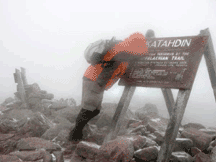 |
Kathy and Greg agreed before they began that if one had to leave the trail, the other would continue. After a strained leg muscle, Kathy was forced to abandon the trail — twice — leaving Greg to reach the summit of Mt. Kathadin alone. |
“Hiking the Whites [mountains] was incredible,” Greg recalls. “It was so beautiful, but really hard. I think I was at my peak physical condition in New Hampshire.”
But after more than five months and almost 2,000 miles, the human body starts to cry out enough! Greg and Kathy had walked through pouring rain, violent thunderstorms, blisters, bloodied knees and insect bites too numerous to count. Both had gone through several pairs of boots. Greg was 30 pounds lighter.
After a month of physical therapy, Kathy was able to rejoin Greg in Abol Ridge, Maine, on September 19. They both hoped her muscle had healed enough so they could summit Mt. Kathadin together.
“As the trail got gradually steeper, it became evident K’ache was having difficulty,” Greg wrote in his journal. “We made it past Katahdin Stream Falls when she shouted up to me to stop. I turned around and she was crying. It broke my heart to see her try so very hard but unable to go any higher. We wanted to stand on the top together, but it was not going to happen. At least not this day. She agreed to head down. I kissed her hard, turned and ran up the mountain not wanting her to see me start to cry. It was time to get this over with.”
Greg reached the summit of Mt. Kathadin on September 21, almost six months to the day after beginning the hike in Georgia.
“As I took the last steps I fell apart crying like a baby. I leaned against the sign marking the summit and wept. I have hiked the Appalachian Trail.”
Back to the Bay
At home in Edgewater, Kathy and Greg are still getting used to being out of the woods and off the trail. Kathy has returned to her job, and Greg is rebuilding his company.
They are planning to return to Vermont next summer, picking up where Kathy left the trail. She knows it will be physically challenging, but she’s anxious to finish. “When we started hiking it wasn’t that important to reach Mt. K,” Kathy says. “But now it’s important to me to finish, to go all the way.”
The Reshetiloffs didn’t start out with expectations of a life-altering experience. They both just “love to camp” and thought six months in the woods would be a “great vacation.”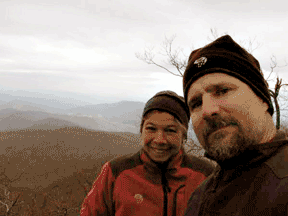
Their six months on the Appalachian Trail affected them to an extent they didn’t anticipate.
They say that they now find crowds, traffic and “all the violence on TV and in the news” hard to handle.
They both said that they have “too much stuff” and have begun to rid their home of the “clutter and excess” accumulated over the years.
“What was I saving this stuff for?” Greg says. “I only collect memories now. I’ve got tons of room for them and they don’t weigh a thing.”
With the help of a financial planner, they are working toward retirement in five years, not the 15 they were previously planning.
Would they do it all over again?
“Probably not,” says Greg. “I believe a journey can’t end until another one begins, and there are too many places out there I still want to go.”
Then, with a sigh, he says. “I’ve always thought about hiking the Pacific Crest Trail.”
See their journey for yourself at www.trailjournals.com/reshetiloff.
Once an avid backpacker, Margaret Tearman, of Huntingtown, has forsaken the call of the trail in favor of central A/C and a Tempurpedic mattress — when she’s not globe trotting. Her latest trip was to Chicken, Alaska, and her last story for Bay Weekly was Battle of the Bandstands (Vol. xiv, No 33: Aug. 17).



